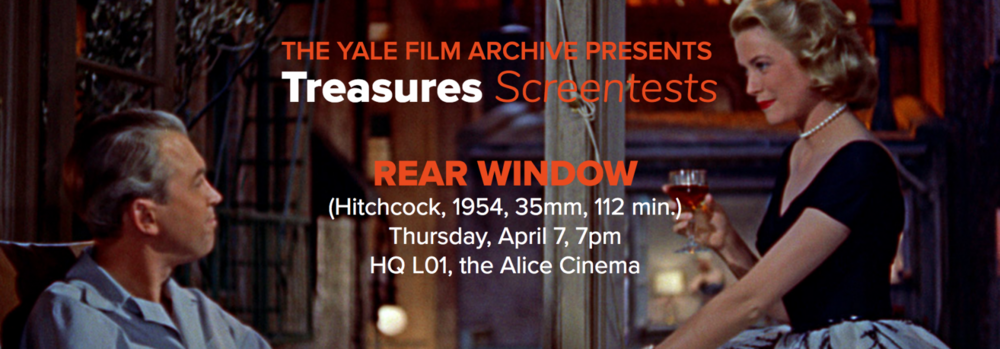Film Notes: REAR WINDOW

REAR WINDOW
7 p.m. Thursday, April 7, 2022
Humanities Quadrangle, Room L01 (320 York)
Introduction by Brian Meacham
Film Notes by Michael Kerbel
PDF
“We’ve become a race of Peeping Toms. What people ought to do is get outside their own house and look in for a change.” L.B. Jefferies (James Stewart) cannot get outside, but he’s also not much interested in the introspection his nurse Stella (Thelma Ritter) is suggesting. The world-roving, thrill-seeking photographer has devoted his life to focusing on others; and now, when he has time to look at himself and his relationship with the “too-perfect” Lisa (Grace Kelly), he’s drawn instead to what he sees across his courtyard. Jeff’s obsessive gazing is not just immensely pleasurable. It validates his fear of domestic entanglement: the married life he observes appears stifling, whether played out whimsically (the newlyweds) or seriously (the Thorwalds).
Although Alfred Hitchcock and scriptwriter John Michael Hayes convey the negative aspects of voyeurism, they don’t condemn it, most obviously because it might solve a mystery, but also because Hitchcock delights in making the audience a race of Peeping Toms (as in the opening of PSYCHO). REAR WINDOW begins with shots of the apartments while Jeff is asleep, establishing us as voyeurs on our own. This exposition includes risqué, censor-challenging views of the ballet dancer on whom Jeff fixates: we are immediately involved in what theorist Laura Mulvey has called the film’s “male gaze.” Throughout, Hitchcock compels our identification with Jeff through an extensive use of point-of-view shots, alternating between Jeff’s face and what he sees. With rare exceptions, we see the apartments only as they can be seen from Jeff’s room. Similarly, the sounds are as Jeff would hear them. The film eschews non-diegetic music: Franz Waxman’s background score is restricted to the jazzy theme under the opening credits and several notes at the end. Otherwise, the music consists entirely of about three dozen cleverly interwoven songs that emanate from the apartments.
In a 1954 review, François Truffaut originated the interpretation, often repeated, of Jeff as a stand-in for Hitchcock: “The courtyard is the world, the reporter/photographer is the filmmaker, the binoculars stand for the camera and its lenses.” One can add that the apartment windows resemble storyboards (a major Hitchcock practice); and, like a filmmaker, Jeff creates characters, devises plots, and “edits” among them. More fundamentally, Jeff is a surrogate for the audience. Like us, he is in one place, relatively immobile, viewing a “screen.” And like us, he wants excitement. It’s what we expect from a Hitchcock film – and then (as he would in THE BIRDS), Hitchcock punishes us with precisely what he manipulated us into desiring. The movie audience is secure from danger because, after all, we’re only watching a screen, a fourth wall. But when that wall is penetrated, it becomes agonizing for Jeff, and for us. And what happens when the screen world, from which we’ve been safely distanced, suddenly acknowledges our presence?
Hitchcock’s films were often on a grand scale (THE 39 STEPS, SABOTEUR, NORTH BY NORTHWEST), but he also enjoyed the challenge of extremely limited locations (LIFEBOAT, ROPE, DIAL M FOR MURDER). To exert maximum control over REAR WINDOW, he insisted that it be filmed entirely in the Paramount studio. Designed from photos taken in New York City’s Greenwich Village, the set was almost 100 feet wide, 185 long, and 40 feet high. This was too large for Paramount’s spaces, so Hitchcock had the floors dug out: the courtyard was below the studio’s basement, and Jeff’s apartment was on the studio’s street level. The set included three buildings and 31 apartments, some completely furnished, as well as a sprinkler system to create a thunderstorm. Cinematographer Robert Burks expertly orchestrated reportedly over 1,000 lights to simulate different times of the day and night, including a stunning sunset.
Whether seen as a triumph of Hollywood magic, a meditation on spectatorship, a romance-comedy-mystery-thriller, a showcase for charismatic stars, or, in Hitchcock’s words, “a purely cinematic film,” REAR WINDOW is best experienced in 35mm on a large screen, and we are proud to present it as our initial showing following a two-year hiatus.
Presented in Treasures Screentests, a limited version of our Treasures from the Yale Film Archive series undertaken as we transitioned out of our COVID-19 closure and into our new screening venues, with support from Paul L. Joskow '70 M.Phil., '72 Ph.D. Printed Film Notes were distributed to the audience before each screening.